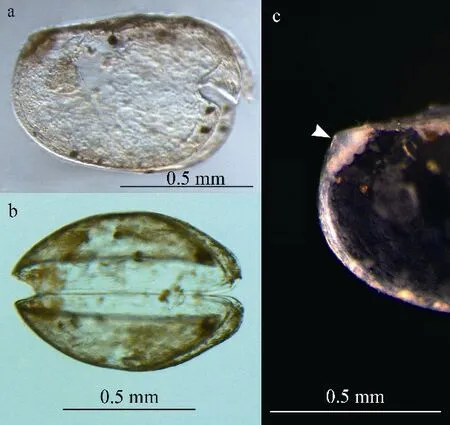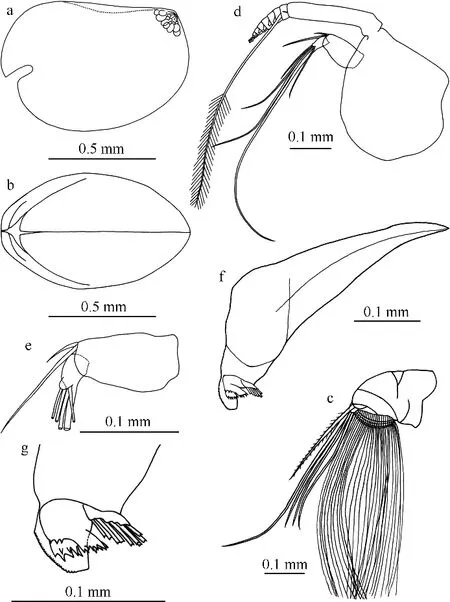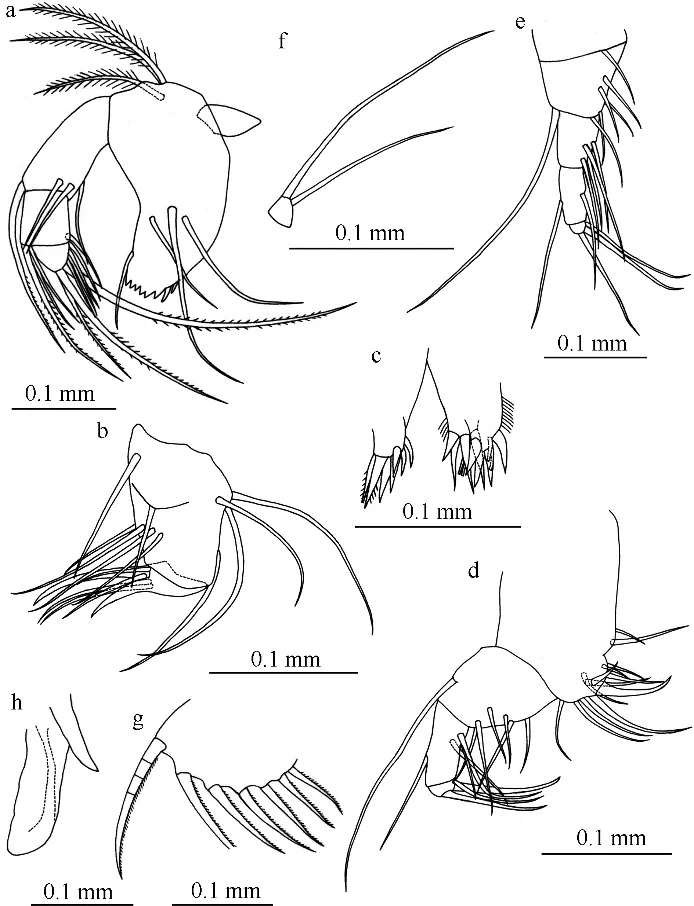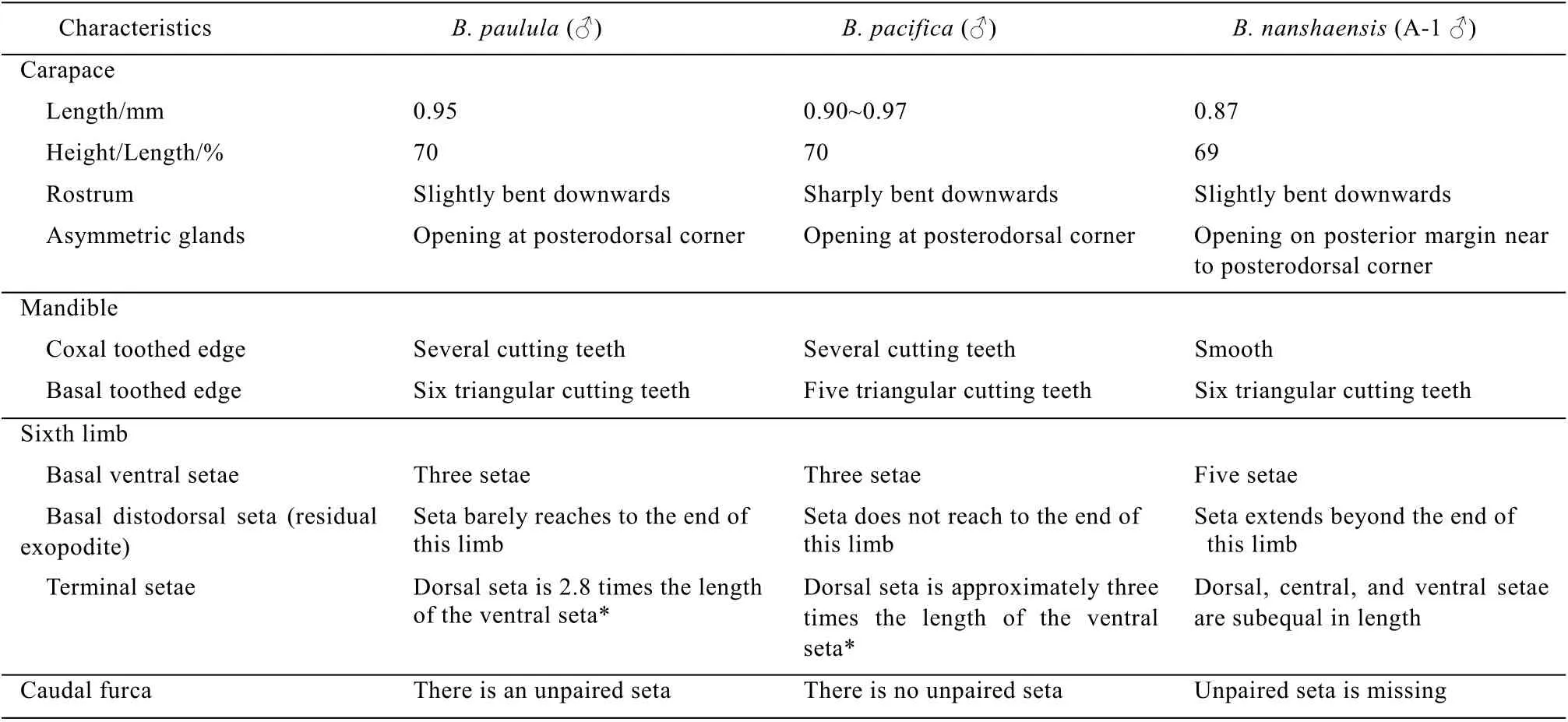Bathyconchoecia nanshaensis sp. nov. (Myodocopa, Halocyprididae), a new species of ostracod from the southern South China Sea*
YIN Jianqiang , LI Kaizhi ,2, TAN Yehui ,2,3
1. Key Laboratory of Tropical Marine Bio-resources and Ecology (LMB), South China Sea Institute of Oceanology, Chinese Academy of Sciences, Guangzhou 510301, China;
2. Southern Marine Science and Engineering Guangdong Laboratory (Guangzhou), Guangzhou 511458, China;
3. University of Chinese Academy of Sciences, Beijing 100049, China
Abstract: A new species of halocyprid ostracod, Bathyconchoecia nanshaensis sp. nov., from the Nansha Trough (the North-West Borneo Trough), southern South China Sea is illustrated and described in detail. The species is a small one that closely resembles Bathyconchoecia paulula Deevey, 1968 and Bathyconchoecia pacifica Chavtur, 1977 in terms of its carapace length (CL; <1.0 mm) and relative height (~70% CL). However, it can be easily distinguished from these species by the locations of its asymmetrical glands’ opening, by the structure of the coxal toothed edge of the mandible, and by the setation of the sixth limb.
Key words: Bathyconchoeciinae; systematics; zooplankton; Nansha Trough; Pacific Ocean
The genusBathyconchoeciawas established by Deevey in 1968 to include six novel species from the Gulf of Mexico together with two species,Bathyconchoecia lacunosa(Müller, 1908) andScottoecia darcythompsoni(Scott, 1909), originally attributed to the genusEuconchoecia(Müller, 1890;Deevey, 1968). Currently, the genusBathyconchoeciais highly polyphyletic and requires substantial revision(Angel, 2012; Angel et al, 2013; Angel et al, 2018).The subfamily Bathyconchoeciinae was established by Angel and Graves in 2013 (Angel et al, 2013) to include two genera,BathyconchoeciaandScottoecia,separated from the subfamily Enconchoeciinae(Poulsen, 1969); and it currently includes six genera:Bathyconchoecia(Deevey, 1968);Scottoecia(Angel,2012);Septemoecia(Angel et Brandão, 2018);Bathyconchoecilla(Chavtur et Bashmanov, 2018);BathyconchoecettaChavtur et Bashmanov, 2018; andSchornikovoeciaChavtur et Bashmanov, 2018(Deevey, 1968; Angel, 2012; Angel et al, 2018;Chavtur et al, 2018a, b, c). Three species of Bathyconchoeciinae in the South China Sea had been recorded:Bathyconchoecia angeliGeorge, 1977,Bathyconchoecia liuiYin et al, 2014 (type locality 113°35′50′′E, 6°4′33′′N), andBathyconchoecia incisaYin et al, 2017 (Yin et al, 1991; Chen et al, 1995; Yin et al, 2014, 2017). Of these, the specimens ofB. incisawere obtained only from the neritic zone. Recently, we re-examined the vertical trawl samples collected from the southern South China Sea during the 1980s by the Multidisciplinary Oceanographic Expedition Team of the Academia Sinica to the Nansha Islands (Yin et al,1991). From one of these samples, we found an immature male specimen of a previously undescribedBathyconchoeciaspecies, which is described and classified as a new species ofBathyconchoeciaherein.
1 Materials and Methods
The material studied was collected using a plankton net from the Nansha Trough (NW Borneo Trough) in southern South China Sea during the Multidisciplinary Oceanographic Expedition Team of the Academia Sinica to the Nansha Islands in 1985 onR/VShiyan 3.
The carapace length (CL), height, and breadth of the specimen were measured using a microscope at 63× magnification with a calibrated eyepiece micrometer. The specimen was dissected, and each of the limbs was placed on separate slides and viewed under a stereomicroscope. The lengths of limbs and setae were measured under a microscope using an eyepiece micrometer. These measurements were standardized by expressing them as percentage of the carapace length (% CL). The complete animal and its limbs were drawn using a camera lucida. The illustrations for publication are inked to these penciled drawings. The carapace of the holotype specimen was photographed using a Leica MC120 HD microscope camera.
2 Results
2.1 Systematics, Holotype, Type locality, and Etymology
2.1.1 Systematics
Class OSTRACODA Latreille, 1802
Subclass MYODOCOPA Sars, 1866
Order HALOCYPRIDA Dana, 1853
Suborder HALOCYPRIDINA Dana, 1853
Family HALOCYPRIDIDAE Dana, 1853
Subfamily BATHYCONCHOECIINAE Angel et Graves, 2013
GenusBathyconchoeciaDeevey, 1968
Bathyconchoecia nanshaensissp. nov.
2.1.2 Holotype
Unique specimen, immature male (A-1 developmental stage, see Kornicker et al, 1975);deposited at the South China Sea Institute of Oceanology, Chinese Academy of Sciences,Guangzhou, China. Registration number SCSMBC 009412.
2.1.3 Type locality
Nansha Trough (NW Borneo Trough),114º28′20′′E, 7º00′51′′N, 7 June 1985, sounding 2972 m, vertical haul from 2950 to 0 m, 0.505 mm mesh net.
2.1.4 Etymology
The specific name refers to the type locality of the Nansha Trough.
2.2 Description
2.2.1 Carapace (Figures 1a~1c, 2a, 2b)
The carapace is very short and high. The CL is 0.87 mm, the height is 0.60 mm (69.0% CL) and the breadth is 0.54 mm (62.1% CL). The anterior half of the carapace is slightly larger than the posterior half.The anteroventral and posteroventral corners are well rounded. The posterodorsal corner is bluntly rounded.The ventral and posterior margins are smoothly bent.The dorsal margin is nearly straight, and there is a long sulcus (about one half of the length of the carapace) on the hinge line. The shoulder vault is well developed and smoothly rounded.
The asymmetrical glands open symmetrically on the posterior margin near the posterodorsal corner.The rostrum is 10.3% CL (measured from the anterior margin of the hinge between the two carapace valves and the tip of the rostrum); slightly bent down and pointed at the tip reaching below the middle of the carapace. The incisure is narrow and its depth (14.9%CL from the tip of the rostrum to the inner margin) is longer than the rostral length. On the rostrum, a reticulate sculpture can be observed in the micrograph of the carapace in Fig. 1a. The valves are thin.

Fig. 1 Micrographs of Bathyconchoecia nanshaensis sp.nov., A-1 male, holotype. (a) Carapace, lateral view; (b)carapace, ventral view; (c) posterior half of carapace (arrow indicates the opening of an asymmetric gland)

Fig. 2 Bathyconchoecia nanshaensis sp. nov., A-1 male,holotype. (a) Carapace, lateral view; (b) carapace, ventral view; (c) first antenna; (d) second antenna; (e) endopodite of second antenna; (f) coxale of mandible; (g) coxal endite of mandible

Fig. 3 Bathyconchoecia nanshaensis sp. nov., A-1 male,holotype. (a) Basale and endopodite of mandible; (b) maxilla(without endites shown in c); (c) precoxal endite (left) and coxal endite (right) of maxilla; (d) fifth limb; (e) sixth limb; (f)seventh limb; (g) caudal furca; (h) copulatory appendage
2.2.2 Frontal organ
The frontal organ is absent.
2.2.3 First antenna (Figure 2c)
The limb is typical of the genus. It is ~26.6% CL and appears to comprise six segments (see Angel et al,2013). The fifth segment carries distodorsally a plumose seta (28.6% CL) and ventrally, a cluster of~200 sensory filaments (~53.7% CL), arranged in 10 rows, with each row comprising ~20 filaments. The last segment carries four terminal setae. The principal seta (55.7% CL) is a little longer than the sensory filaments, and the remaining three setae are of similar length (39.4%, 37.4%, and 39.1% CL, respectively).
2.2.4 Second antenna (Figures 2d, 2e)
The left and right limbs are similar. The protopodite is pear-shaped and 36.7% CL in length.The exopodite comprises nine segments. The first exopodite segment (26.6% CL) is nearly straight and carries a small terminal seta that does not reach the third segment. Segments 2~9 each carries a long swimming seta; they have a combined length of 12.2%CL. The longest of the swimming setae is 60.1% CL.The endopodite comprises three segments. The first endopodite segment is elongate (12.2% CL) and almost rectangular, and a third of the length of the protopodite; it carries two bare distodorsal setae. The shorter a-seta (4.4% CL) is approximately one-third of the length of the longer b-seta (13.4% CL). The second endopodite segment (3.6% CL) is ~30% of the length of the first endopodite segment, and carries two terminal setae, which are 45.2% and 65.4% CL,respectively. The third endopodite segment is small,knob-like, and bears three terminal setae of various lengths.
2.2.5 Mandible (Figures 2f, 2g, 3a)
The toothed edge of the coxal endite is smooth,and the anterior edge is serrated. The proximal and distal teeth lists comprise double rows of sharply pointed teeth. On the masticatory pad, there is a clump of robust, long columnar spines with spinous tips. The toothed edge of the basal endite has six triangular cutting teeth armed with secondary serrations, and two spine teeth (one pointed, the other bluntly rounded).The first cutting tooth is slightly offset from the others.The exopodite is represented by three moderately long plumose setae inserted on the dorsal margin of the basale. The lateral seta on the basale is absent. The basal endite has one shorter, bare anterior seta and three bare lateral setae. The endopodite is threesegmented. The first segment has one finely spinose and long distodorsal seta, which extends well beyond the end of the limb, and three bare ventral setae. The second segment has one spinose and two bare distodorsal setae, and a single bare subterminal ventral seta. The last segment bears seven terminal setae, the longest of which is extremely long (34.8% CL) and almost 170% of the length of the endopodite.
2.2.6 Maxilla (Figures 3b, 3c)
The precoxal endite has seven setae. The coxal endite is distally divided into two lobes. It has a total of 12 setae, four of which are tube-like. The basis carries one bare seta. The endopodite comprises two segments. The first segment has four bare anterior setae (three proximal and one distal) and five bare posterior setae (one proximal and four distal). The terminal segment has two stout terminal claws and a pair of slender setae on either side.
2.2.7 Fifth limb (Figure 3d)
The epipodial setae are in three groups of four(not shown). The precoxale has two bare ventral setae. The coxale has nine bare setae and two claws on the ventral face. The basale has six bare ventral setae and one long dorsal seta (a remnant of the exopodite, see Angel, 2012) that extends past the end of the limb. The endopodite is two-segmented. The first segment has a bare dorsal seta and three bare ventral setae. The last segment has three terminal setae, two of which are claw-like and stout. The dorsal seta (9.2% CL) is slightly shorter than the central one (9.4% CL).
2.2.8 Sixth limb (Figure 3e)
The epipodial setae are in three groups of five(not shown). The coxale has a bare distoventral seta.The basale has five bare ventral setae, and an extremely long distodorsal seta (a residual exopodite,see Angel, 2012) that extends beyond the end of the limb. The endopodite comprises three segments. The first segment has two pair of bare ventral setae. The second segment has a bare ventral seta and a bare dorsal seta. The terminal segment bears three slim terminal setae, which are subequal in length. The dorsal, central and ventral setae are 13.2%, 13.3% and 13.7% CL, respectively.
2.2.9 Seventh limb (Figure 3f)
The limb is small and short. It bears terminally two long, although unequal, setae.
2.2.10 Caudal furca (Figure 3g)
Each lamella has seven long, slim, weak claws,all with two rows of spines on the posterior edge. The first claw is 16.8% CL in length and has three faint sutures. The unpaired seta is missing.
2.2.11 Copulatory appendage (Figure 3h)
The appendage is relatively short (~14.6% CL)and bluntly rounded at the tip.
2.3 Remarks
The present species is a smaller species (<2.0 mm,see Deevey, 1968). It closely resemblesB. paulula(Deevey, 1968) andB. pacifica(Chavtur, 1977) in terms of its CL (< 1.0 mm) and relative height (~70%CL) (Deevey, 1968; Chavtur, 2014). Nevertheless,differences betweenB.paulula,B.pacifica, andB.nanshaensissp. nov., notably in the locations at which the asymmetrical glands open, and also in the structure of the coxal toothed edge of the mandible and the setation of the sixth limb are particularly significant.Their main morphological characteristics are compared in Table 1.
Key toBathyconchoecia paulula,B. pacificaandB. nanshaensis
1. Asymmetric glands opening on posterior margin near to posterodorsal corner; coxal toothed edge of mandible smooth················B. nanshaensissp. nov.
– Asymmetric glands opening at posterodorsal corner;coxal toothed edge of mandible with several cutting teeth·····································································2
2. Basal toothed edge of mandible with six triangular cutting teeth; caudal furca with an unpaired seta··········································B.paulula(Deevey, 1968)
– Basal toothed edge of mandible with five triangular cutting teeth; caudal furca without unpaired seta·········································B. pacifica(Chavtur, 1977)
3 Discussion
Most Bathyconchoeciiae species are benthopelagic at bathyal to abyssal depths (Angel et al, 2013). They inhabit in water just above the seabed and are thus rarely collected using plankton nets; several of the known Bathyconchoeciiae species were originally described from juvenile specimens:Bathyconchoecia lacunosa(Müller, 1908);Bathyconchoecia diacantha(Deevey, 1975);Bathyconchoecia arctica(Angel,1976);Septemoecia deeveyae(Kornicker, 1969);Septemoecia septemspinosa(Angel, 1970);Septemoecia omega(Kornicker et Rudjakov, 2004)(Kornicker, 1969; Angel, 1970, 1976; Deevey, 1975;Kornicker et al, 2004; Angel et al, 2013). Kornicker et al (1975) researched the juvenile development ofS.septemspinosa. Based on the number of claws on the caudal furca, the holotype specimen ofB. nanshaensissp. nov. is an A-1 instar, that is, the final juvenile stage.The carapace lengths ofB. pacificaat the same stage of development (A-1 instar) were 0.80~0.84 mm(Chavtur, 2014); therefore,B. nanshaensissp. nov.should be similar toB.pacificain size.

Tab. 1 Comparison of the main morphological characteristics of male Bathyconchoecia paulula, Bathyconchoecia pacifica, and Bathyconchoecia nanshaensis sp. nov.

